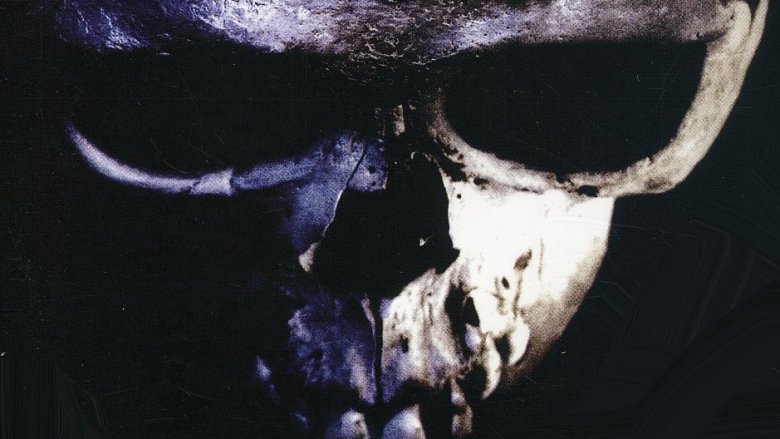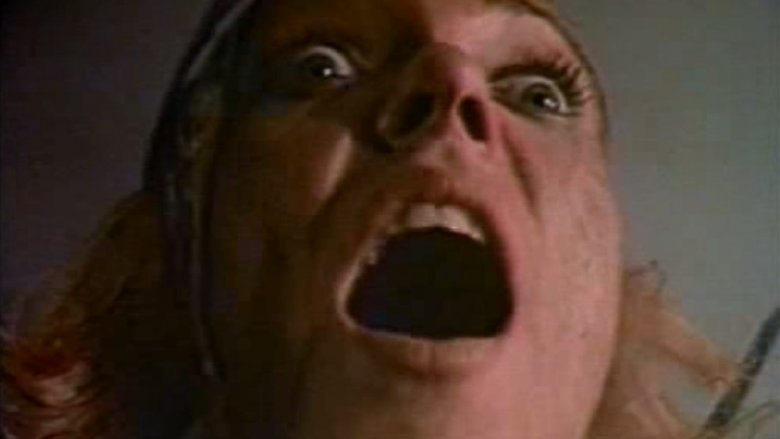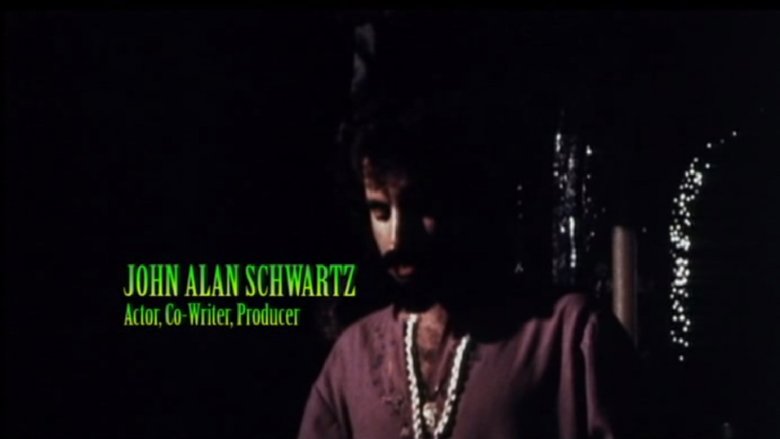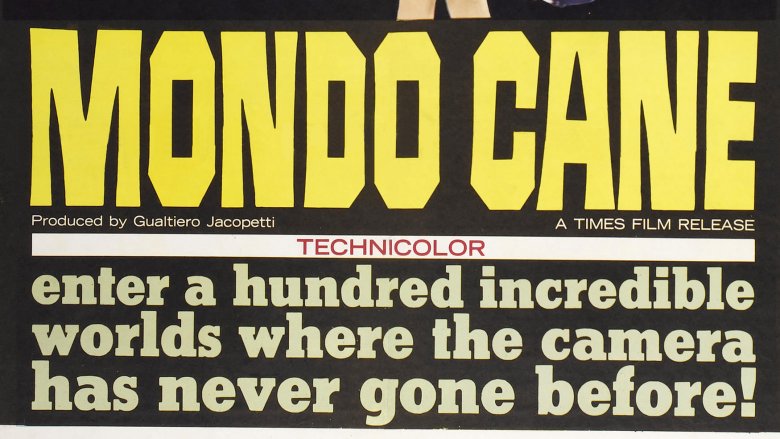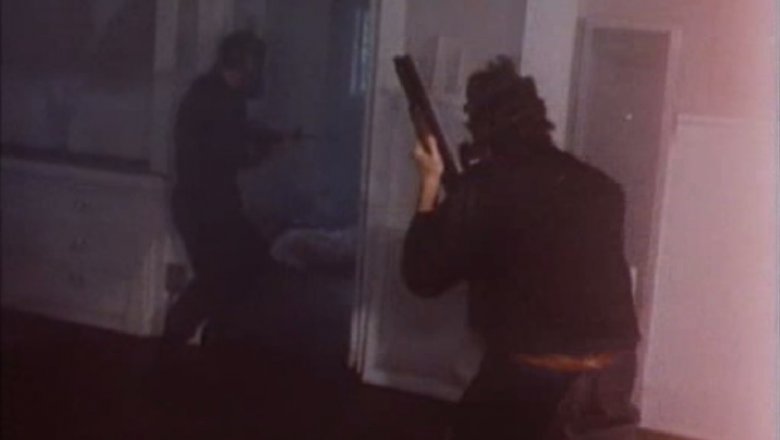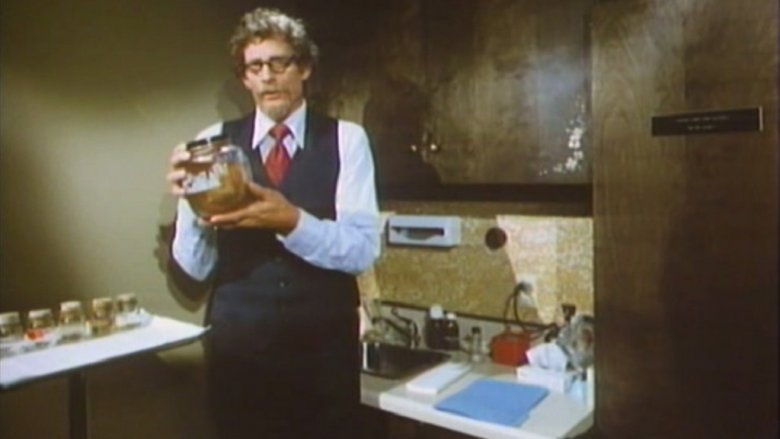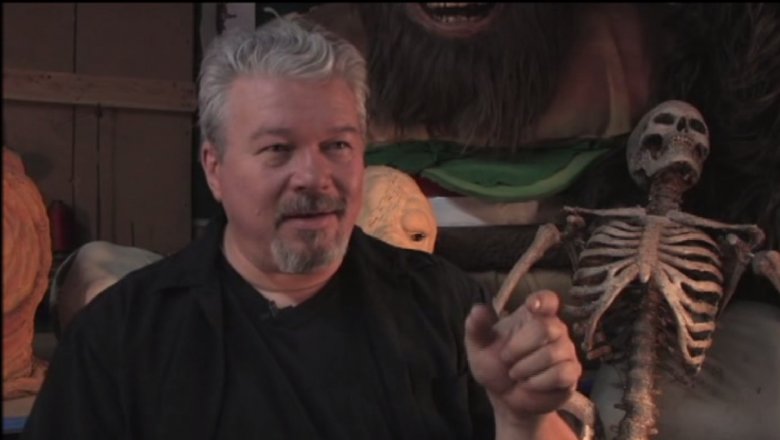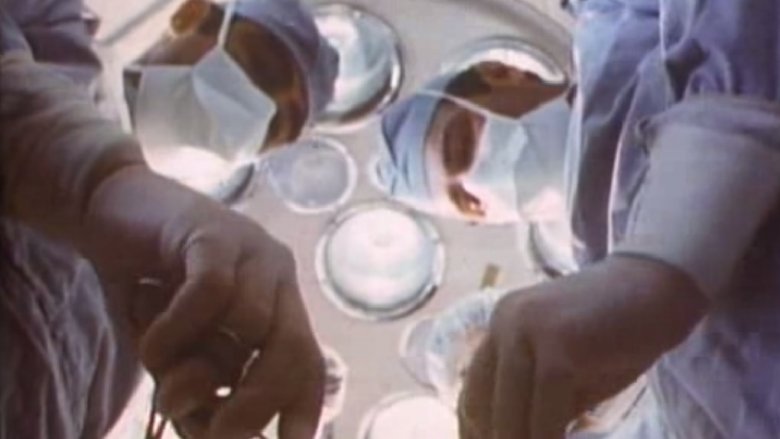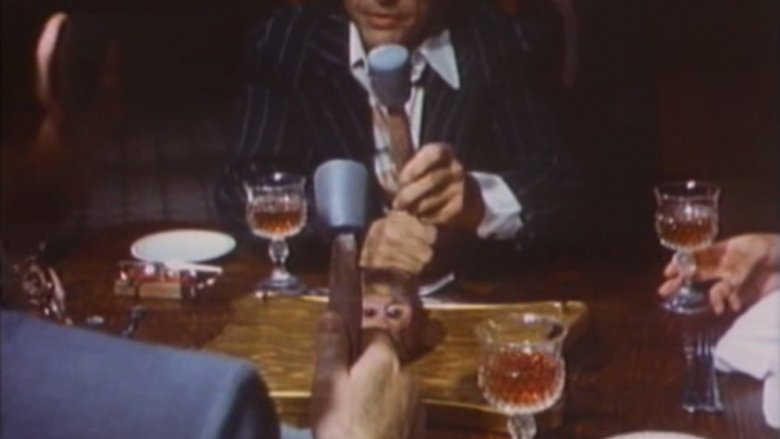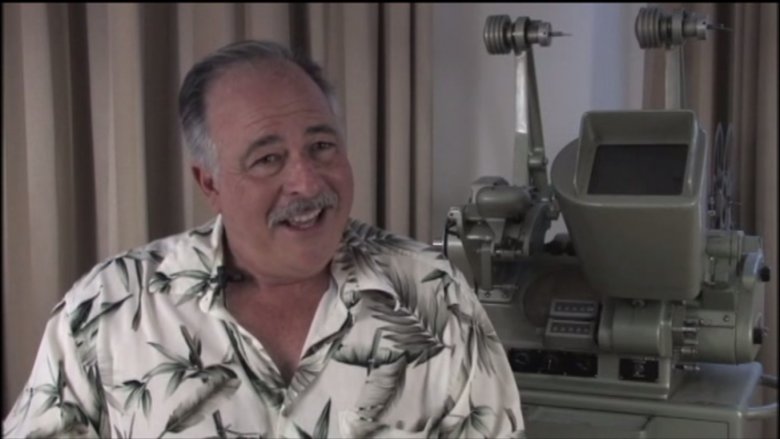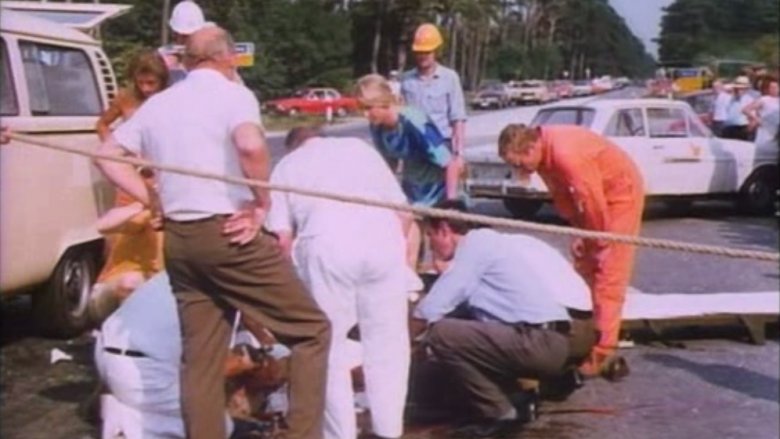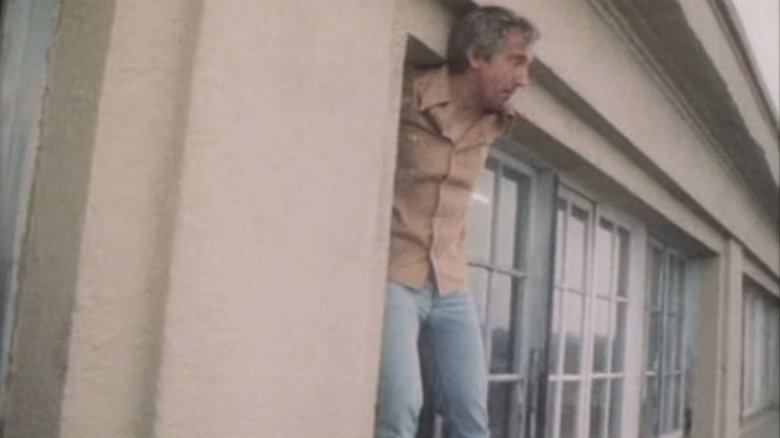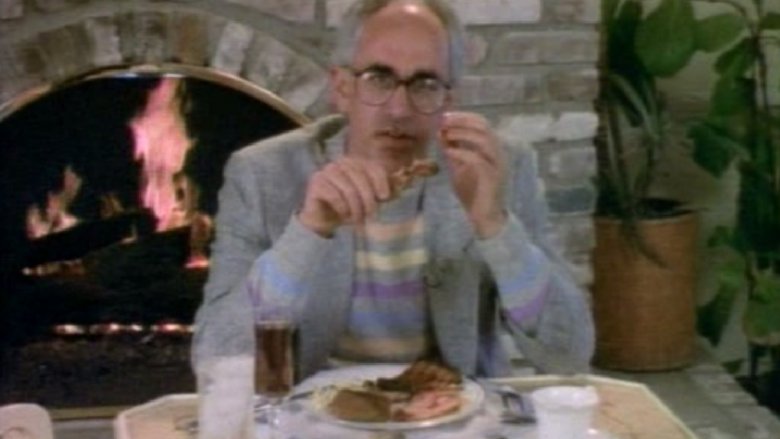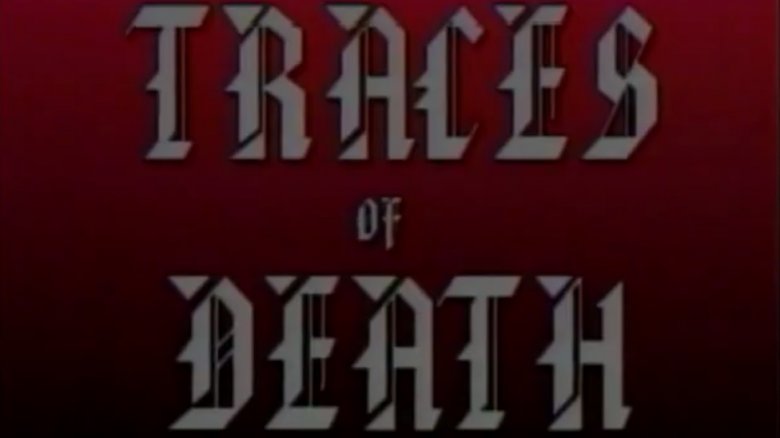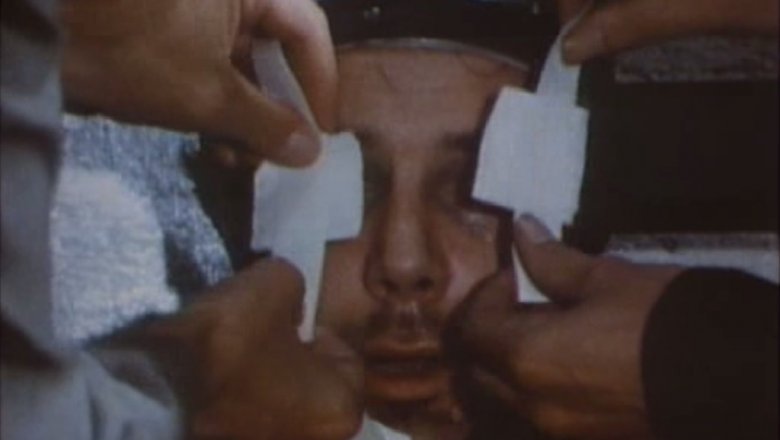The Untold Truth Of Faces Of Death
Nothing holds a strange fascination in pop culture like the concept of a snuff film. It's an idea that's simultaneously repulsive and magnetic—why would anyone want to watch illicit footage that catches someone in the final moments of their life? On the other hand, if someone presented you with a chance to see something like that, would you really be able to look away?
The 1978 horror movie Faces of Death proved there was a wide audience of people with a morbid curiosity they were looking to satisfy. Sometimes described as the first found footage film, it made waves across America—from the viewers who experienced it to the media pundits who denounced it as yet another sign of American culture's sad decline.
But while many may have opinions about Faces of Death, they often don't really know what they're talking about. It was a movie? A series of movies? Isn't that a snuff film? Did I just watch somebody die?
The answer is more complex than you think. Come along on our postmortem examination as we explore the untold truth of Faces of Death.
The origin of an urban myth
Since its release in 1978, Faces of Death has been passed down from weird older brothers and cool aunts everywhere to new, unsuspecting generations, always looking to make their world a little bigger in search of the next taboo. It's really the only way to explain the movie's appeal—unlike, say, The Shining, Faces of Death can't be appreciated for its awe-inspiring cinematography, or a gripping and layered story with universal relevance. The taboo surrounding death lends the movie its entire morbid appeal.
Beyond that, there's the "Is this real?" aspect. People being shot, people being executed, people set on fire—the footage brings up a reaction. "Did this really happen? Am I really seeing this?" Who knows? Part of the culture around Faces of Death is the wealth of misinformation that surrounds it, some of it deliberately planted in marketing materials. Then there's people repeating falsehoods about the movie to their friends, either because they don't know any better or because they want to make the movie scarier.
"Each new generation discovers it, and even though things look hokey now, there are still segments that people actually believe are real that aren't," producer John Alan Schwartz said in a 2012 interview. And he would know—Schwartz is the sole creator of the Faces of Death series, though you won't find his name in the credits.
The creator
If you go by the credits, the responsibility for Faces of Death falls on two principal figures: Alan Black, who wrote the movie, and Conan Le Cilaire, the director. But both of these mysterious individuals are actually one person: John Alan Schwartz, who was also a main producer on the movie, and even acted in some of its sequences.
"Of all the things I've written, the most organic was Faces of Death," Schwartz later said, after deciding to reveal his identity as the series' creator to the wider public. The movies, he said, served "as a mouthpiece to say whatever I wanted to say, with nobody censoring me. We were our own censors, but we didn't censor anything. The darker we got, the more excited we were."
It wasn't an original idea. Faces of Death was made with money from Japanese investors for the Japanese video market, who approached Schwartz to make the movie with their idea in mind. "The Japanese came to this small family film company and said to us, we want to make a movie about death," said Schwartz. "It was a chance to have complete creative control. And what young aspiring filmmaker wouldn't want to do that? They gave us the money and we put it all together and never had anybody to answer to but ourselves."
The project came to America thanks to a collection of independent distributors, who saw the film and saved it from a life of obscurity.
The context
Faces of Death appeared at a time when filmmakers were beginning to push the boundaries of what a movie even was. Specifically, Faces of Death falls into the "mondo" genre, a term which was practically invented upon the 1962 release of the movie Mondo Cane.
In essence, the mondo movie is a provocative film designed to shock. Originally, they focused on taboos, usually cultural ones, showing foreign people engaging in behaviors western audiences would seemingly be put off by—which often turned out to be cruel footage of animals being beaten and killed, a trope that is prominently featured in the Faces of Death series.
By the end of the 1970s, this boundary-pushing, which started in a place we would today find remarkably tame, had progressed to the point that, for the sake of shock value, mondo films started purporting to show real violence and death onscreen. "So you think you've seen everything," the thinking went. "Well you ain't seen nothing like this."
The footage
So what's actually in Faces of Death?
Well... lots of footage of the dead, from tame portraits of corpses in coffins to up-close surgical shots of opened-up bodies. There's animal slaughter of the sort you'd see in a movie trying to scare you into veganism, and a fatal shootout between armed civilians and police. Bodies are shown so carved up that they're barely recognizable, and purported traditions of death from around the world are shown in an out-there sequence of human sacrifice, followed by cannibalism. In one famous scene, a group of diners sits down to a meal of fresh monkey brains, scooping them out of the skull after beating the monkey to death right at the dinner table.
As a movie, Faces of Death proceeds clinically, with a lot of emotional distance between the viewer and the footage—audiences aren't exactly being invited into an unfolding story here. Played over a sparse soundtrack, it doesn't have much structure—its one connecting thread is an onscreen host and narrator, a buttoned-down sort who introduces himself as Dr. Francis Gross. The unrelated footage that makes up the bulk of the movie is stitched together under the pretext of being the doctor's long-term study on the different methods and manners of death.
Sound like it might be up your alley? Don't be shy. A whole lot of people were on board for Faces of Death, and they paid for the tickets to prove it.
Fans catch on
Faces of Death was released theatrically on the second weekend of November 1978, where it went on to earn an incredible $35-40 million, a seemingly ludicrously successful performance for a movie that purported to show an unvarnished look at real death. It made its money largely in less-reputable theaters, venues of the drive-in and the trashy grindhouse sort.
But while the movie's theatrical success is astonishing to consider, the movie didn't really secure its immortality until after its VHS release in 1983. Snappy branding which claimed the movie was banned in 46 countries made Faces into something forbidden, an irresistible draw for any prospective viewer wanting a taste of the transgressive.
As the movie gained success, it also received pushback, with many commentators writing off the film as a monstrosity. Ironically, their outrage only served to cement the movie's reputation.
"One night I was working in my typist's house," Schwartz recalled later. "Dan Rather was the anchor for CBS News, and Dan Rather said: 'there's a movie out called Faces of Death that should never have seen the light of day.' And I figured I'd never work in Hollywood again. But it actually had the opposite effect."
How they did it
For all it purported to be an unblinking look at the real world, most of Faces of Death was total fiction. Obviously so—even the seediest theater couldn't get away with showing a film of people really killing and eating a human body. But the inclusion of some real archival material built an enduring uncertainty into the series' sequences, and the marketing was suggestive as well.
It's startling how many people don't believe this, but almost everything in Faces of Death was the result of a regular film production. While there's plenty of footage of actual corpses in the archival segments, no real person actually died onscreen. Not even the monkey. "Cauliflower for the brains," Schwartz later revealed. "Theater blood for the blood."
"We watched hours and hours and hours of newsreel footage," said Douglas White, the special make-up effects creator for the movie. They also studied real, grisly crime scene photos to make sure their effects looked true to life. Many sequences were recreations of real news footage, painstakingly replicated with a budget of $450,000.
One scene of a violent dogfight wasn't actually violent at all—just two dogs playing, cleverly edited. "We couldn't believe that anyone would buy this," said Michael Felsher, who produced behind-the-scenes material for Faces of Death's 30th anniversary DVD. "But you add sinister music and some sound effects and cut it a certain way, and it looks like these dogs are killing each other."
What was real
What's real and what's fake in the movies has been a topic of debate for decades. But honestly, it's not difficult to tell the difference between the real archival footage and the showbiz stuff. In the days of VHS, when tapes were grainy and the internet couldn't clear up confusion, it was easy to spread the belief that some wretched videotape contained footage of real murder. But no one really got sacrificed, and the only thing that was real about the monkey brains sequence was the actors' grossed-out reactions to the mushy cauliflower they were eating.
The only real, unscripted sequence in the first film occurred when a body washed up on shore while the crew was shooting at Sunset Beach, California. Allan Apone, an effects creator for the movie, described the experience 30 years later.
"We were out there, and this person comes running up saying there's a body on the beach, there's a body on the beach," Apone said. "We ran down there to see what was going on." What they found was a drowned man, who had apparently been missing for a couple of days after deciding to go for a swim while intoxicated.
Despite the fact that it was ultimately just another movie, multiple people who worked on the production either changed their names or went uncredited for their work. Can't be too careful when you're on the crew of a snuff film.
The special effects
Allan Apone, along with Douglas White, had a relatively new special effects company when he was approached by the Faces of Death filmmakers for a project of a peculiar nature. "They wouldn't give us any of the information about it," Apone said in a DVD interview. Together, their team did essential work in crafting the movie's most memorable moments.
One of their most infamous productions was the first movie's monkey brain dinner sequence, which was not the portrait of genteel barbarity many took it as. Instead, it was your regular movie effects shot, with a special table and mallet made specifically for the movie, a trained live monkey, and a dummy monkey to take the fatal blow.
The filmmakers hid the parts of the sequence that didn't work with quick cuts, and the result is pretty seamless. In addition to the monkey sequence, Apone's company was in charge of the police shootout, the scene where someone gets eaten by an alligator, the decapitation sequence, and the cult sacrifice—basically, all of the good stuff.
And they clearly did an outstanding job—to this day, the movie's effects creators maintain that people approach them insisting that the movie is real, refusing to believe them when they explain the tricks they used, or that everyone who supposedly died in the movie is still walking around just fine.
Assembling the edit
Editor Glenn Turner (who worked under a pseudonym) was approached by Schwartz to help construct the movie. Speaking for a special feature included with the 30th anniversary edition of Faces of Death, he said he needed a little bit of convincing before jumping on board. "I'm all for it, so long as it's a legitimate documentary," he said.
In making their original version of the movie, they didn't use reenactments or special effects at all, instead stitching together "a tremendous amount" of real footage which they bought directly from news stations. This meant that originally, the movie was just a long reel of dead bodies, which in addition to being upsetting, isn't very narratively interesting or fun. "We knew it was very difficult to watch," Turner said.
It was upon this realization that the filmmakers decided to take the approach of recreating scenes. It was the only way to have the movie's individual vignettes tell complete stories, rather than just showing the gory aftermath. To get their movie scenes, they painstakingly recreated real accident footage such as a massive train accident, taking care to get details such as lighting as realistic to the original shots as possible.
"We would study the shot of somebody leaping out of a window, and we would look at the kind of stocks they were using for film and the type of camera person that they happened to be using at the time, if they were very shaky in their moves or whatever," Turner said.
Faces of Death II
The success of the first Faces of Death movie was completely unexpected for the filmmakers. Their assumption was that they would never see their footage again—that it would be shipped off to Japan's domestic video market and fade into memory. But earning so much money on a $450,000 budget guaranteed there would be a series of sequels, the first of which followed in 1981.
Again written and directed by John Alan Schwartz and again hosted by the detached tone of Dr. Gross, Faces of Death II was largely more of the same, but worse. Not worse in a gory sense—worse in that it's not nearly as transgressive or weirdly entertaining. Where the first Faces of Death had imaginative sequences and even some action scenes, most of the sequel is canned disaster footage, or lethal accidents during sporting events.
You get the feeling, throughout the sequel, that the filmmakers are scrambling to get up close to feature length, throwing as much real footage as they can into the edit in order to make the picture a serviceable length. A 1980 boxing match between Lupe Pintor and Johnny Owen that later resulted in Owen's death outside the ring is shown extensively.
The movie's still sometimes gory and gross, with its share of corpses and creepy medical footage, but overall it's very tame compared to the kinds of insane things that today you can pull up on YouTube by accident.
Faces of Death III
A third movie followed four years later, once again directed and written by Schwartz with a co-writer credited as Veronica Lakewood. It's far and away the most interesting sequel in the franchise. Faces of Death III featured a return to the reenactments that made the first movie interesting, though whether due to the actors' performances, the staging of the shots, or the editing of the movie, it's much easier to tell that what you're watching didn't really happen.
As a result, the sequences in the third movie are considerably more fleshed-out and dramatic. One sequence of the capture and subsequent trial of a notorious serial killer named Mike Lorenzo plays out like a miniature Law and Order episode, with an interesting interlude where the courtroom is presented with video footage of the killer in the process of committing his crimes. (The director, John Schwartz, played the entirely fictional killer.)
More interesting scenes include harrowing footage of a Los Angeles suicide jumper (played by Schwartz's brother James), standing on the edge of a building as police and medical professionals try and fail to help him. With much more diversity in its scenes and settings than Faces of Death II, the overall effect of the movie is similar to the first one—it becomes a kind of fever dream of weird, grainy footage, that you'll later half-remember, wondering if it might've been real.
Faces of Death IV
The fourth movie, released in 1990, is also considerably more interesting than the first sequel, even if the franchise's wheels are clearly starting to come off. In a change from the previous three movies, this one was written by the director's brother James, who also appears in the movie as Dr. Louis Flellis, taking over hosting duties. (Naturally, the previous host is explained as having died by suicide.)
Although the sequel is again credited to the fictitious director Conan Le Cilaire, real-life directing duties were split three ways between John Schwartz and two others, Susumu Saegusa and Andrew Theopolis. Perhaps as a consequence of the new creative team, the fourth movie is far campier, with a number of sequences played for laughs, like the above picture of Schwartz's Dr. Flellis enjoying a plate of barbecue after a hard cut from a prisoner's execution.
The content of Faces of Death IV is all over the place, from protracted sequences of magic tricks gone wrong, archival footage of mob murders, capital punishment being exacted via electrocution, the aftermath of deadly accidents, and a return to the taboo cultural motifs of the old mondo movies in a sequence presenting a Vietnamese-American family killing and eating a dog. This was the final Faces of Death movie to feature any original footage, with two entries that came after being just repackaged old material, and it comes off like a fun-house mirror compilation version of all of the movies that came before it.
Copycats and ripoffs
The lasting influence Faces of Death had in its macabre niche can be seen in the number of copycat movies that emerged in the years following its rise to trade on its name.
The most obvious of these, Traces of Death, was released to video in 1993. More mean-spirited than the Faces of Death movies, Traces features a narrator who more actively critiques and comments on the footage of the dead—a lot of which is, evidently, real archival news and crime scene footage. A selling point of the movie was "Absolutely NO Staged Scenes!"
It's highly possible that they're telling the truth. But the result is a movie that's also boring, with some segments being nothing but slide shows of crime scene photos, or the kinds of gross medical pictures you can find in the "infection" section of a high school biology book. Despite this, Traces of Death spawned four sequels of its own of varying quality.
1999 saw the release of a movie called Faces of Gore, which copied the structure of Faces of Death almost exactly, right down to the unsettling doctor for a host. But though that series used more "real" footage, what ends up standing out as unique about Faces of Death are its painstaking reenactments, which so frequently walk the line between fantasy and reality that they stick with you.
A legacy of death
Although two more Faces of Death films were released during the '90s, they were sequels in name only, made up exclusively of repackaged footage from the prior installments. The franchise, today, is effectively dead, its existence unnecessary in a world where anyone who has internet access is sadly able to instantaneously pull up plenty of footage of the dead and dying that's definitely real, and always worse.
As for the death makers, many of the people who worked on Faces of Death went on to have robust careers in show business, including Schwartz. He may have made the series his lasting legacy, but it didn't necessarily earn him a financial fortune; Schwartz guesses that he only made $15,000 from the original film, which is shocking relative to the millions of dollars screenings alone brought in. "The companies that reap the benefits had nothing to do with making the movie," Schwartz later said.
So how does Schwartz feel about the legacy of the movie series he created? After all of the intense reactions, the rumors, and the reputation the series gained as being something sinister, he's not exactly sure. "I don't know if it's a source of pride," he said.
One thing he is sure of, though? That's easy: "We did a good job fooling people."
